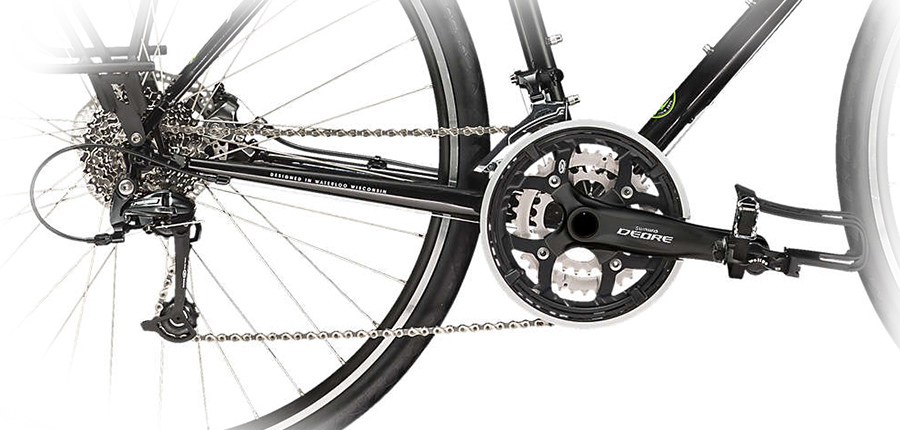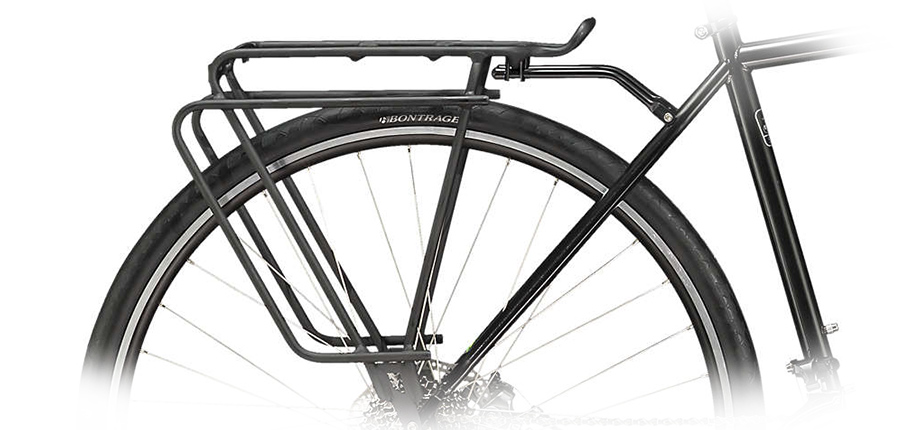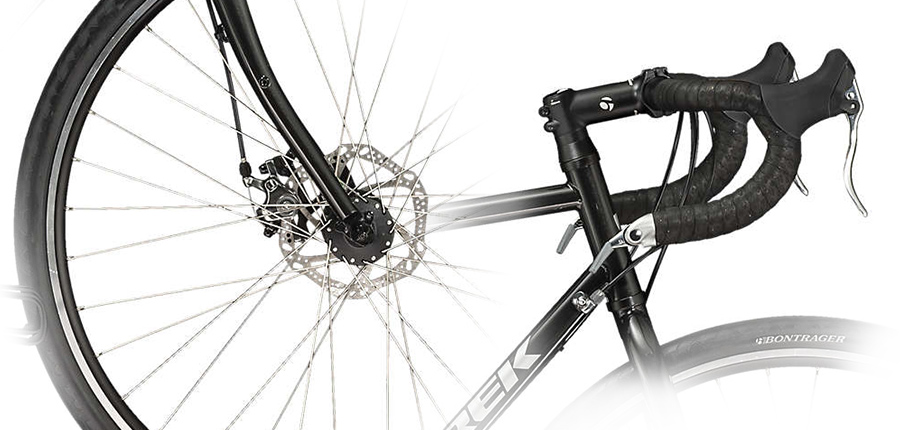Road Test: Trek 520
If the Trek 520 were a person instead of a bicycle, it would be old enough to run for president.
Not to serve, mind you — not this term anyway. The Trek 520 is “only” 34 years old, a year short of the constitutional requirement for ascension to the presidency. Anyway, that position has been filled.
Hiring policies in the nation’s capital notwithstanding, the 520 remains the elder statesman of the Trek line, according to Eric Maves, curator of the Trek Historical Collection.
“Thirty-four consecutive years in the product line; no other Trek model comes close to that track record,” he said.
As you might expect, this venerable touring bike has seen a few changes since 1983, when Ronald Reagan was in the White House and I was in the newspaper business. The lugged Reynolds 501 tubeset has given way to welded 4130; chainstays and wheelbase have stretched a couple of centimeters; and the brakes have evolved from sidepulls through cantilevers to mechanical discs.
But, at rock bottom, the 520 remains stable, sturdy, and steel, available in six sizes from small to tall, and anyone who liked it in ’83 is liable to like it today.
Heck, if you were a fan 10 years ago, you’ll probably be one now because the 520 isn’t much different. Why mess with success?

Components
You’ll find quite a few Shimano components on the 520 — 36-hole M475 hubs with quick-release skewers, Deore M590 triple crankset, Alivio and Deore derailers, Dura-Ace bar-end shifters, and a nine-cog HG50 cassette.
And, because this is a Trek, you’ll see a lot of Bontrager bits too, as in just about everything else. Stem, handlebar, tape, seatpost, saddle, rims, tires, rear rack — even the sealant in the inner tubes bears the B.
There are a few exceptions. The brakes are Hayes CX Expert mechanical discs, with levers from Tektro, just as on the comparably priced Kona Sutra, which I reviewed in May 2014. The chain is a KMC X9. And the pedals are Wellgos, with toe clips and straps.
Gearing is what you’d expect from a touring bike with more than three decades on the road — a 48/36/26T triple up front and an 11–32T cassette in back. The Deore trekking crank even includes a chainguard to keep lube off your chinos, if you occasionally do your cycling in street clothes.
And the color is basic black, which is always in style.
A Little History
My first Trek was considerably less subtle. That 1985 560 was an eye-popping purple and yellow, like a bruise with wheels, which seemed oddly appropriate as my years spent working a series of copy desks had left me looking a bit puffy.
I rode the wheels off it, shedding weight and a nicotine habit, and I know 520 owners who have recouped similar value from their Treks. A friend’s wife still loves her ’09 model, which has been converted to a flat-bar bike, and a neighbor only recently sold his 520 after first transforming it into a singlespeed.
But when it comes to finding out what the bike is truly capable of, I tip my hat to the late great David Lamb. In 1994, the veteran Los Angeles Times correspondent rode his 520 more than 3,000 miles from the Potomac to the Pacific, eventually spinning the three-month journey into a book, Over the Hills: A Midlife Escape Across America by Bicycle.
In an excerpt reprinted in Adventure Cyclist, he wrote, “My American-made bike — a Trek 520 — proved as roadworthy as the most expensive Mercedes-Benz, and it strikes me as remarkable that such a simple contraption was capable of carrying me so far without extracting a single penny for fuel, oil, or mechanical repairs.”
Twenty-three years later, the descendant of Lamb’s bike seems equally well suited to adventures large and small.

Size and Carrying Capacity
With sizes ranging from 48cm to 63cm, fit shouldn’t be an issue for most customers. A 57cm fit me like an old slipper, with an assist from the short-reach, shallow-drop Bontrager VR-C bar. The Blendr-compatible stem lets you mount lights, computers, and accessories above or below the faceplate. And because pedals and a rear rack are included in the $1,360 price tag, you’ll be ready to roll as soon as the credit card clears.
That rack, a Bontrager BackRack Deluxe L, is rated for a maximum of 55 lbs. The company doesn’t offer a front rack for the 520, but I had a Tubus Ergo low-rider on hand; it needed a few spacers to clear the fork’s stout lower legs and disc-brake caliper.
Performance
Once on the road, the 520’s performance was just what you’d expect from a bike that was all about adventure before the concept became a category. The ride was relaxed but responsive — just the ticket for those impromptu coast-to-coast getaways — and the Bontrager AW1 Hard-Cases felt surprisingly plush for an all-weather, puncture-resistant 32mm tire. You can go bigger if you want, but I found the Hard-Cases well suited to my rides around Albuquerque.
Snapping through the gears was a breeze with the Dura-Ace bar-cons and Alivio/Deore derailers all meshing nicely. I do have an aesthetic problem with that Alivio front derailer — it looks boxy, cheap, and clunky, especially sitting next to that triple crank with its equally obtrusive chainguard — but the solution is to avoid looking down while riding. Trust me. After a while, I forgot that my ’85 560 looked like the upshot of a hard left to the ribs and just rode the bike.
Trust me. After a while, I forgot that my ’85 560 looked like the upshot of a hard left to the ribs and just rode the bike.
The Alivio derailer may not be sexy, “but it is functional, reliable, and easy to find an economical replacement for, should the need ever arise,” said David Studner, Trek’s assistant product manager for city bikes. “The low-clamp/top-swing format is also more durable by virtue of its tucked-away design.”
This was good to know because I found myself using that front derailer more than usual. I’m sloppy about shifting, generally slouching around in the middle ring until some emergency arises, but with the Trek I found I wanted to be in the little ring if using the 28T or 32T cog to keep a clean chainline and avoid the occasional auto-downshift from the middle ring.

Brakes
I don’t see the Hayes mechanicals as often as I do the Avids, but they impressed me on the Kona Sutra and I like them here too. This is another good thing because the rim-brake 520 has been discontinued effective this year. Thus, the disc-brake model is the only one you’ll see at your local dealer. When I picked up my review bike at the Albuquerque Trek Superstore, manager Mike Humphries had just one lonely V-brake 520 on the floor, which seemed to be where it would stay.
Oh, you can still have one if you must. Studner said both the disc- and rim-brake 520 framesets are stocked as service parts for $660, so if you break yours, or just want one to build to your own specifications, see your friendly neighborhood Trek dealer.
Or you could save yourself the time, hassle, and expense, and go with the instant gratification of the modern 520 to get started on your own midlife escape from the Potomac. The Pacific awaits.
Patrick O’Grady has written and cartooned about cycling since 1989 for VeloNews, Bicycle Retailer & Industry News, and a variety of other publications. Read more from and about Patrick O’Grady here.
Trek 520
- Price:$1,360
- Sizes available:48cm, 51cm, 54cm, 57cm, 60cm, 63cm
- Size tested:57cm
- Weight:29.4 lbs with rear rack, stock pedals with toe clips and straps, and reflectors front and rear
Test Bike Measurements
- Stack:587mm
- Reach:383mm
- Head tube length:160mm
- Head tube angle:71.8°
- Seat tube:543mm (center to top of seatpost clamp)
- Seat tube angle:73.5°Top tube:557mm (effective)
- Chainstays:450mm
- Bottom bracket drop:70mm
- Fork offset:52mm
- Fork trail:59mm
- Wheelbase:1052mm
- Standover:794mm
Specification
- Frame:4130 butted chromoly. Rack and fender mounts, disc mounts, pump peg, chain hanger, three sets of bottle bosses, down tube cable routing, down tube bosses for shifters/barrel adjusters
- Fork:Chromoly with rack and low-rider mounts, and fender and disc mounts
- Headset:VP Slimstak, sealed semi-cartridge bearings
- Rims:Bontrager tubeless ready
- Hubs:Shimano M475, 36-hole, QR
- Tires:Bontrager AW1 Hard-Case, 700c x 32mm
- Crankset:Shimano Trekking M590 with chainguard, 175mm, 48/36/26T
- Bottom bracket:Shimano sealed cartridge, threaded
- Cassette:Shimano HG, 11–32T, 9-speed
- Brake levers:Tektro RL340 aero
- Shift levers:Shimano Dura-Ace bar-cons
- Front derailer:Shimano Alivio
- Rear derailer:Shimano Deore
- Brakes:Hayes CX Expert mechanical disc, 160mm rotors
- Stem:Bontrager Elite, 100mm, 31.8mm four-bolt clamp, 7° +/-, Blendr compatible
- Handlebar:Bontrager Race VR-C, 440mm, 85mm reach, 125mm drop, 31.8mm clamp diameter
- Seatpost:Bontrager SSR, two-bolt head, 27.2mm, 12mm setback
- Saddle:Bontrager Evoke 1
- Rear rack:Bontrager Back Rack Deluxe L, 55 lbs
- Pedals:Wellgo R125 with toe clips and straps


